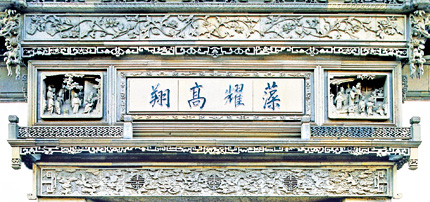Expo features Old City preservation
|
|
| Exquisite carvings inside Wangshi Garden. [Shanghai Daily] |
Suzhou's preservation of its ancient streets, gardens and houses is featured at the World Expo 2010 in Shanghai in the Urban Best Practices Area.
"The Protection and Renovation of the Suzhou Old City" is a model for China and the world about how to protect ancient heritage alongside modern structures and how to harmonize the two.
Notable features are Pingjiang Road, the oldest and best-preserved road in Suzhou. It received the UNESCO Asia-Pacific Cultural Heritage Award in 2005.
But Pingjiang Road is only one of many ancient streets, gardens and houses in the 14.5-square-kilometer Old City area that is cherished by the people of Suzhou and its government.
Classic gardens, such as Zhuozheng Yuan (Humble Administrator's Garden) and Liu Yuan (Lingering Garden), and Shantang Street are also famous for preserving their original charm.
Since 1982, the Chinese government has approved 110 National Famous Cities of History and Culture, but few have successfully preserved their beautiful heritage in the face of hectic economic development, says Ruan Yisan, director of the National Research Center of Historic Cities at Tongji University.
Suzhou is an exception.
"The Old City of Suzhou today is still located where our ancestors first set it up more than 2,500 years ago," says Suzhou Mayor Yan Li. "The long history of the town bequeathed us rich and colorful heritage such as the classic gardens, temples and streets, which must be preserved for ourselves and future generations."
Compared with the original Pingjiangfu Tu (Map of Pingjiang County) drawn by government official Li Shoupeng in 1229, Pingjiang Road today preserves the original layout and styles of architecture.
There are low houses along the riverside and delicate bridges connecting numerous waterways. Tangjia, Tongli Zhong'an and many other bridges still bear the names they were given 800 yeas ago.
"That is the typical image of Suzhou - composed of river, bridge and residences and they are easily distinguished from any other cities in the world," says Ruan who has been involved in historic preservation around China.
He has helped protect the old town of Pingyao in Shanxi Province, and old towns in Jiangnan (region south of the Yangtze River) such as Zhouzhuang, Tongli, Luzhi, Nanxun, Wuzhen and Xitang.
Every historic city reveals the wisdom of the ancestors in one way or another, and China has recognized more than 2,000 ancient and distinctive cities, each with their own landscape and architecture.
But reckless urbanization has often bulldozed many beautiful cities and parts of cities. Rows of identical box-like structures replace distinctive local architecture.
Ruan once compared pictures of Lanzhou in Gansu Province and Changsha in Hunan Province and found little difference in their modern landscape and architecture, though the settings, culture and history are dramatically different.
Fortunately, old Suzhou survives.
To address the issues of Old City protection and modernization, Suzhou government set up new industrial zones in the east and west and new residential areas in the north and south. This left space for the Old City and ensured it would not be further crowded.
The government expanded the original protection area from 43 hectares to 116 hectares in 2003. Since 2005 it began to repair, renovate and reconstruct more than 1,000 old streets and lanes, as well as 39 old residential communities.
In 1986 the government established building regulations for the Old City area, limiting building height to 24 meters.
From North Temple Pagoda, one can enjoy a panoramic view of the Old City, without any obstruction by modern buildings.
All the facilities and structures in the Old City, either old or new, must blend in architecturally and maintain the colors of black, gray and white, like the originals.
Architecture experts are consulted on repair and reconstruction, so that the city retains as much as possible of what is old and authentic.
"Protecting an old city is much more difficult than protecting an antique," says Ruan from Tongji University. "You can simply protect an antique by locking it in a museum, but a city is only alive with people living in it."
 0
0 







